HOME
ANIMALS
BIRDS
Condors
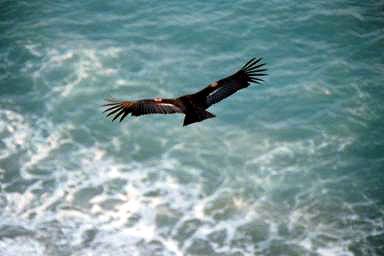 Condor
is the common name for two large American vultures, the Andean
condor and the California condor. Both are among
the largest living flying birds.
The Andean condor has the larger wingspread, reaching about 10.5
feet; the wingspread of the California condor does not exceed about
9.5 feet. The California condor is somewhat heavier, weighing up to
31 pounds, male Andean condors weigh about 25 pounds.
Condor
is the common name for two large American vultures, the Andean
condor and the California condor. Both are among
the largest living flying birds.
The Andean condor has the larger wingspread, reaching about 10.5
feet; the wingspread of the California condor does not exceed about
9.5 feet. The California condor is somewhat heavier, weighing up to
31 pounds, male Andean condors weigh about 25 pounds.
Both condors have sooty-black
body plumage and a large white area in the wing. The naked head of
the Andean condor is dull red, and the males have a prominent fleshy
comb on the forehead. A fluffy white ruff encircles the lower neck.
California condors lack the comb, but the naked skin of the head of
adults is bright yellow and red. The neck ruff is of long, pointed,
black feathers.
Condors lay their single eggs on
rock ledges or on cave floors. The young develop slowly, beginning to
fly at about six months of age. Both species feed almost entirely on
carrion; the Andean condor may occasionally attack wounded or newborn animals.
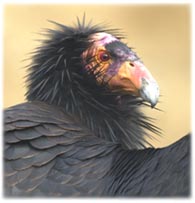 CALIFORNIA
CONDOR
CALIFORNIA
CONDOR
Up to about 10,000 years ago,
California Condors ranged over much of North America, but by the 20th 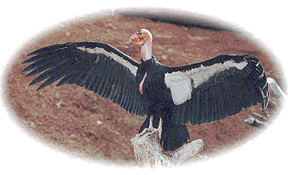 Century,
the population occurred only in central and southern California and
northern Mexico. Condors are among the rarest birds in the
world, owing to loss of food supply, excessive shooting, lead
poisoning, and other causes.
Century,
the population occurred only in central and southern California and
northern Mexico. Condors are among the rarest birds in the
world, owing to loss of food supply, excessive shooting, lead
poisoning, and other causes.
In 1987, there were only 21
California condors left in the wild. These few surviving condors
were brought into captivity. A breeding program was begun in 1988,
with the intent of raising sufficient numbers in captivity at the Los
Angeles Zoo and The San Diego Wild Animal Park to permit the return
of condors to the wild in some appropriate areas.
In 1994, The Peregrine Fund's
World Center for Birds of Prey was added as a third location for the
breeding program. The first successful breeding of captive
condors was accomplished in 1988. As more and more pairs
reproduced successfully, the condor population has grown to over 150 today.
The goal of the project is to
re-establish a 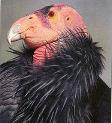 self-sustaining
population in the wild. Beginning in the 1990s, biologists
initiated releases of captive-produced young condors into the wild in
the species' former range at sites in California and Arizona.
self-sustaining
population in the wild. Beginning in the 1990s, biologists
initiated releases of captive-produced young condors into the wild in
the species' former range at sites in California and Arizona.
Biologists from The Peregrine
Fund are conducting the releases near the Grand Canyon in
Arizona. These are the first California Condors to fly outside
of California in 70 years. The success of the project can be
demonstrated by the numbers. There are now more California
Condors in the wild in Arizona than there were in the world in
1982. Courtship behavior is being displayed by some condors and
breeding in the wild could occur in 2002 or 2003.
ANDEAN CONDOR

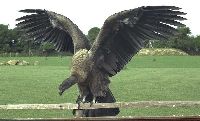 The
great wing surface of Andean condors allows them to soar on rising
air currents almost indefinitely. The birds are black with white
patches on the wings and a white ruff around the neck. Their heads
are naked, but the male has a fleshy comb. Males have brown eyes;
females have garnet red eyes. They have been known to live more than
75 years in captivity.
The
great wing surface of Andean condors allows them to soar on rising
air currents almost indefinitely. The birds are black with white
patches on the wings and a white ruff around the neck. Their heads
are naked, but the male has a fleshy comb. Males have brown eyes;
females have garnet red eyes. They have been known to live more than
75 years in captivity.
The Andean Condor
was once found in the Andes Mountains of South America from Venezuela
to the islands of Tierra del Fuego in the Strait of Magellan. They
are generally confined to areas where strong winds are available to
support their soaring flight. These habitats include; deserts that
produce strong thermals, high mountains with deflected winds off the
steep slopes, and coasts where sea breezes deflect off dunes.
Condors are
scavengers or carrion feeders. They soar aloft, a highly energy 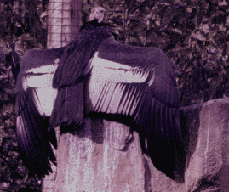 efficient
method of hunting, watching for carcasses. They have excellent
eyesight and watch the actions of other animals as clues to food.
They are not equipped to hunt as their feet have blunt claws instead
of the sharp talons of raptors. The beak is strong but is best
adapted to tear meat that is already rotting. They clean their naked
heads by scraping them along the ground to remove debris from their
meals. Inland on the pampas or the slopes of the Andes, they feed on
carcasses of farm animals or wild ungulates. On the coast they feed
on the beached carcasses of marine mammals and raid sea bird colonies
for eggs and nestlings.
efficient
method of hunting, watching for carcasses. They have excellent
eyesight and watch the actions of other animals as clues to food.
They are not equipped to hunt as their feet have blunt claws instead
of the sharp talons of raptors. The beak is strong but is best
adapted to tear meat that is already rotting. They clean their naked
heads by scraping them along the ground to remove debris from their
meals. Inland on the pampas or the slopes of the Andes, they feed on
carcasses of farm animals or wild ungulates. On the coast they feed
on the beached carcasses of marine mammals and raid sea bird colonies
for eggs and nestlings.
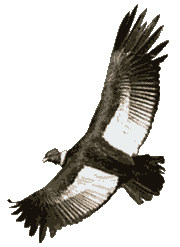 The
male begins his courtship display by drawing himself erect, fully
extending his wings, and clicking his tongue, while the reddish skin
of his neck becomes bright yellow. The female lays a single egg
which both parents incubate for about 54-58 days. Fledging takes
another 180 days so that a pair only breeds every other year under
normal conditions. Parents continue to care for the fledgling for a
full year.
The
male begins his courtship display by drawing himself erect, fully
extending his wings, and clicking his tongue, while the reddish skin
of his neck becomes bright yellow. The female lays a single egg
which both parents incubate for about 54-58 days. Fledging takes
another 180 days so that a pair only breeds every other year under
normal conditions. Parents continue to care for the fledgling for a
full year.
The Andean Condor
is officially listed as endangered, although it has greater numbers
than its California relation. Biologists estimate that a few thousand
birds remain in the wild, concentrated mostly along the southern
portion of their historic range. Threats are illegal shooting,
habitat disturbance, poisoning from lead shot in carcasses, or poison
placed for mammalian predators. Thirty-nine Andean Condors reared in
North American facilities have been reintroduced to the wild in
Columbia and Venezuela. Early reports from the field indicate that
some of these released birds have begun to breed. The work that
preceded the attempt to breed California Condors in captivity, which
has been very successful so far, was modeled on Andean Condors, from
hand puppets that were used to feed the chicks through to the final
release techniques.
Scientific
classification: Condors belong to the family Cathartidae of the order
Falconiformes. The Andean condor is classified as Vultur gryphus and
the California condor as Gymnogyps californianus.
References:
Del Hoyo, J.,
Elliot, A. and J. Sargatal. eds. 1994. Handbook of the Birds of the
World. Vol. 2. New World Vultures to Guineafowl. Lynx Edicions, Barcelona.
Newton, I. ed.
1990. Birds of Prey. Facts on File, New York.
Swaringen, K.,
Wiese, R.J., Willis, K., and M. Hutchins eds. 1995. AZA Annual Report
on Conservation and Science. American Association of Zoological Parks
and Aquariums, Bethesda, MD.
Microsoft ®
Encarta ® Encyclopedia 2002. © 1993-2001 Microsoft
Corporation. All rights reserved.
Major support for
The Peregrine Fund's California Condor project is from the U.S. Fish
and Wildlife Service, Geraldine R. Dodge Foundation, Burns Family
Foundation, Patagonia, The Turner Foundation, Wallace
Research Foundation, Jane Smith Turner Foundation, Globe Foundation,
Phelps-Dodge, Kearney Foundation, Norcross Wildlife Foundation, Bank
One, Sidney S. Byers Charitable Trust, Ten Times Ten
Foundation, Salt River Project, and Arizona Public Service.
Links to other
great condor sites:
http://www.peregrinefund.org/press/condview.html
http://natzoo.si.edu/Animals/Birdfacts/andeancondor.htm
 Condor
is the common name for two large American vultures, the Andean
condor and the California condor. Both are among
the largest living flying birds.
The Andean condor has the larger wingspread, reaching about 10.5
feet; the wingspread of the California condor does not exceed about
9.5 feet. The California condor is somewhat heavier, weighing up to
31 pounds, male Andean condors weigh about 25 pounds.
Condor
is the common name for two large American vultures, the Andean
condor and the California condor. Both are among
the largest living flying birds.
The Andean condor has the larger wingspread, reaching about 10.5
feet; the wingspread of the California condor does not exceed about
9.5 feet. The California condor is somewhat heavier, weighing up to
31 pounds, male Andean condors weigh about 25 pounds. CALIFORNIA
CONDOR
CALIFORNIA
CONDOR Century,
the population occurred only in central and southern California and
northern Mexico. Condors are among the rarest birds in the
world, owing to loss of food supply, excessive shooting, lead
poisoning, and other causes.
Century,
the population occurred only in central and southern California and
northern Mexico. Condors are among the rarest birds in the
world, owing to loss of food supply, excessive shooting, lead
poisoning, and other causes.  self-sustaining
population in the wild. Beginning in the 1990s, biologists
initiated releases of captive-produced young condors into the wild in
the species' former range at sites in California and Arizona.
self-sustaining
population in the wild. Beginning in the 1990s, biologists
initiated releases of captive-produced young condors into the wild in
the species' former range at sites in California and Arizona. 
 The
great wing surface of Andean condors allows them to soar on rising
air currents almost indefinitely. The birds are black with white
patches on the wings and a white ruff around the neck. Their heads
are naked, but the male has a fleshy comb. Males have brown eyes;
females have garnet red eyes. They have been known to live more than
75 years in captivity.
The
great wing surface of Andean condors allows them to soar on rising
air currents almost indefinitely. The birds are black with white
patches on the wings and a white ruff around the neck. Their heads
are naked, but the male has a fleshy comb. Males have brown eyes;
females have garnet red eyes. They have been known to live more than
75 years in captivity. efficient
method of hunting, watching for carcasses. They have excellent
eyesight and watch the actions of other animals as clues to food.
They are not equipped to hunt as their feet have blunt claws instead
of the sharp talons of raptors. The beak is strong but is best
adapted to tear meat that is already rotting. They clean their naked
heads by scraping them along the ground to remove debris from their
meals. Inland on the pampas or the slopes of the Andes, they feed on
carcasses of farm animals or wild ungulates. On the coast they feed
on the beached carcasses of marine mammals and raid sea bird colonies
for eggs and nestlings.
efficient
method of hunting, watching for carcasses. They have excellent
eyesight and watch the actions of other animals as clues to food.
They are not equipped to hunt as their feet have blunt claws instead
of the sharp talons of raptors. The beak is strong but is best
adapted to tear meat that is already rotting. They clean their naked
heads by scraping them along the ground to remove debris from their
meals. Inland on the pampas or the slopes of the Andes, they feed on
carcasses of farm animals or wild ungulates. On the coast they feed
on the beached carcasses of marine mammals and raid sea bird colonies
for eggs and nestlings. The
male begins his courtship display by drawing himself erect, fully
extending his wings, and clicking his tongue, while the reddish skin
of his neck becomes bright yellow. The female lays a single egg
which both parents incubate for about 54-58 days. Fledging takes
another 180 days so that a pair only breeds every other year under
normal conditions. Parents continue to care for the fledgling for a
full year.
The
male begins his courtship display by drawing himself erect, fully
extending his wings, and clicking his tongue, while the reddish skin
of his neck becomes bright yellow. The female lays a single egg
which both parents incubate for about 54-58 days. Fledging takes
another 180 days so that a pair only breeds every other year under
normal conditions. Parents continue to care for the fledgling for a
full year.